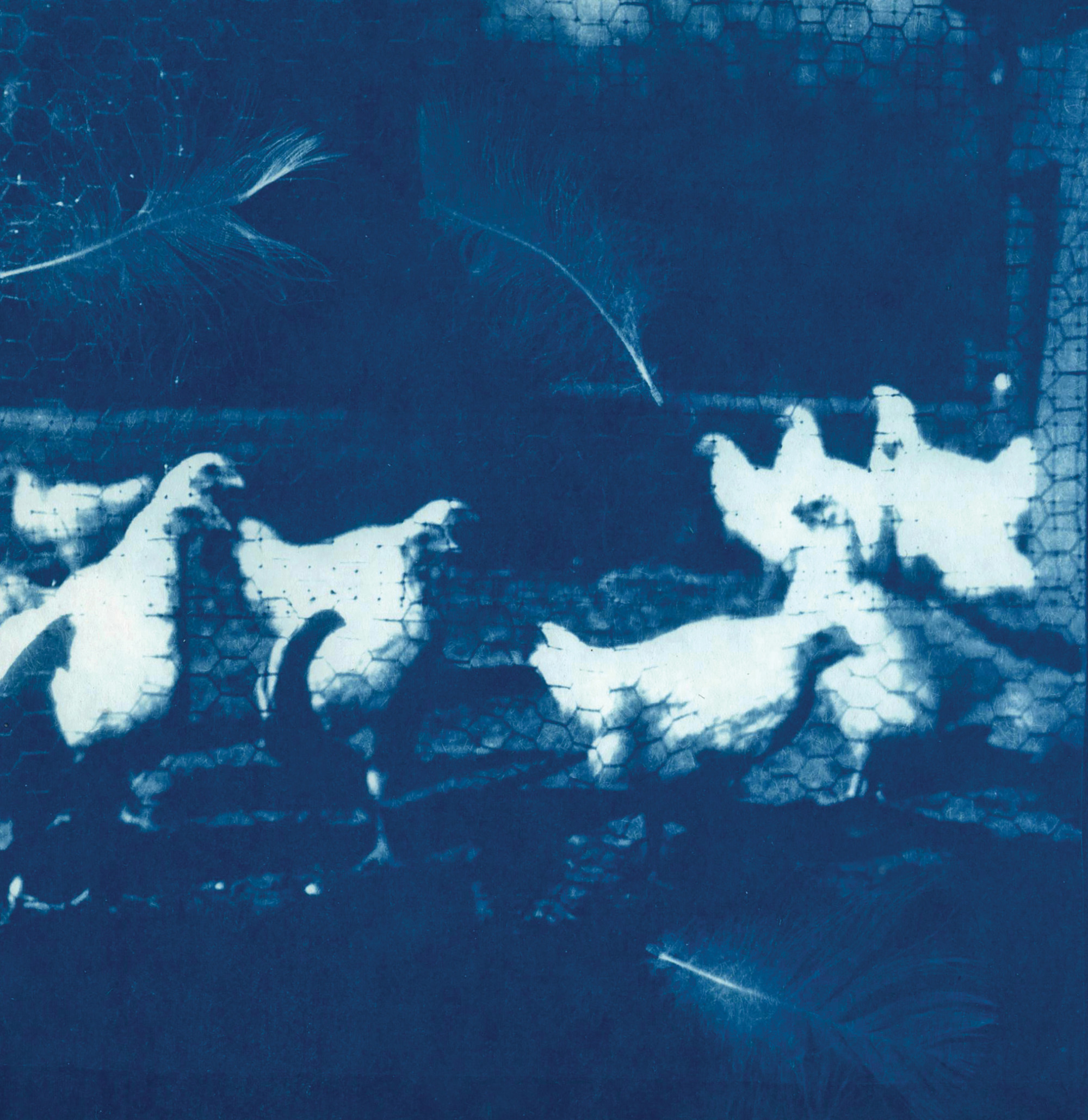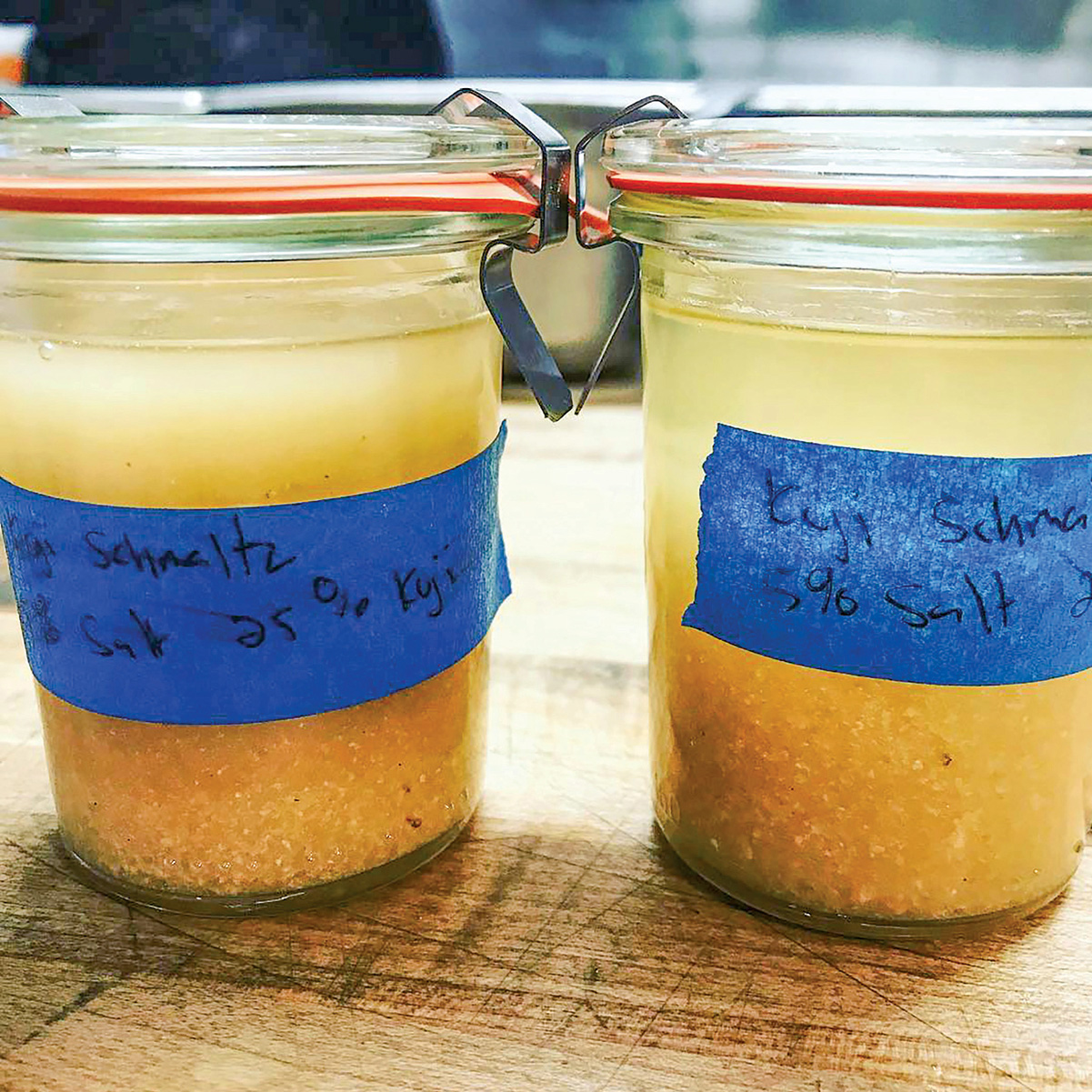Schmaltzy: Fat and Flavor on the Southern-Jewish Table
By Madeline Weinfield

Pullets with feathers, 2015, a cyanotype from film positive, by Alexis Doshas.
Ask different people what rendered fat is and you’ll get a different answer each time.
Growing up, rendered fat was lard, or the bacon drippings my aunt kept and reused from a tin can balancing precariously over her stove. It was also schmaltz, the rendered chicken fat my German Jewish grandmother used when she served chicken liver pâté before meals on holidays.
In the meals of my childhood, lard and schmaltz as cooking staples were mostly just faraway concepts, things used in relatives’ kitchens, and not something my own parents used to cook with at all. Rendered fat played less of an actual role in my life than a conceptual one, and schmaltz in my family’s home was not so much an ingredient as it was a word in our limited Yiddish vocabulary. Its adjectival form—schmaltzy—was the ideal choice for something overtly campy or soapy or something with just a little too much extra (the end credit tunes on a British murder mystery or a proposal scene in a Hallmark Christmas movie, for example).
Schmaltziness aside, these two rendered fats—lard and schmaltz—are staples in their respective Southern and Jewish kitchens. At their cores, the two are very similar, yet differ significantly in their origins. Lard is rendered fat from a pig, but since pork is not an ingredient found in Jewish cooking, schmaltz, rendered from the fat of a chicken or goose, is used instead. Despite their prevalence, neither fat, nor their associated cultures, was something I paid that much attention to before adulthood. That was when I started learning more about the culinary traditions of the South—a place I will always observe with the microscope of a transplant, no matter how long I live here—and also about my Ashkenazi Jewish heritage. Michael W. Twitty and his wildly successful book Koshersoul brought the throughlines of Southern and Jewish cooking into popular consciousness, and I was curious to understand more. And like anything vaguely schmaltzy, or cooked in lard, it’s a complicated, delicious story to try to understand.
Food writer and recipe developer Stephanie Ganz grew up in southern Virginia. Her Jewish father had relatives in the Bronx in New York, and her non-Jewish mother had relatives that Ganz describes as “Appalachian, vaguely Christian, mountain folk” from “real moonshine territory” in rural Virginia. Living with her mother following her parents’ divorce, Southern cooking, and its requisite lard, became the dominant tradition in Ganz’s early culinary education.
“I grew up with a lot of pork and a lot of pork fat being used,” she says. “We used pork fat to cook; we would make bacon every weekend and we would render the fat from that and save it in a tin. And then we kept the tin by the stove, and we would use that to cook with throughout the week.”
It wasn’t until she was in adulthood that Ganz was curious to explore her Jewish ancestry more fully. “I knew I was Jewish, but it was like I didn’t have those doors open to me,” she says. “At the time, there was no one who wanted to help me come into that part of my identity.” When she and her husband had children, they sent them to Jewish preschool, and Ganz began her Jewish education alongside everything they were learning at school. It was around that time that she decided to observe Shabbat with family meals on Friday nights. It was a decision made “not really super religiously, but just almost as like a family kind of observance.”
It was through those Shabbat meals that she came to schmaltz. “I started roasting chicken every week. And so I would have schmaltz from the chicken. It definitely reminded me of that experience of having the pork fat and using it. It was very familiar in that way. And the big difference, I would say, is that for whatever reason, I don’t know if it was just my sensibilities had changed, but I kept the schmaltz either in the freezer or in the refrigerator. I didn’t just have, like, a bowl of schmaltz on the counter the way that I would have with the pork fat. But because I pretty much roast a chicken every week at this point, there’s just always a stockpile of schmaltz.”
For chef Ian Boden, schmaltz and other staples of his Jewish-Southern cooking came to him through his ancestors. “It all came from both of my grandmothers,” he says, “one of them being adamantly Jewish, the other one being very passively Jewish.” Boden, who started cooking as a teenager, trained in the French culinary tradition and cooked for about twenty-five years before realizing that the influences of his Jewish grandmothers and, by proxy, his Ashkenazi ancestors, were permeating his dishes. Today, his successful restaurants, The Shack and Maude & The Bear, are places of immense local pride, dining rooms people travel to Staunton, Virginia, specifically to visit. Do his patrons recognize the Jewish influences in his cooking?
“Opening The Shack is what made me kind of say, you know, maybe I should explore this [connection] a little bit more. And the reason that I think that happened is more because of my wife and her family and their roots in the area that I live in now, and me trying to connect with her family through food.”
Memories of schmaltz stored in his imagination, Boden cooked meals for his Southern in-laws and started to see parallels between those tables and the Jewish tables of his childhood. “I just started to see a lot of similarities between the way that they ate, the way that they took care of each other, the sense of camaraderie and home. I saw a lot of parallels with that and traditional Jewish homes.”
Of course, this has always been how culinary traditions intermingle and play off each other. Perhaps nowhere is this more apparent than in the Southern Jewish tables of South Carolina, a state that has a record of a Jewish person arriving as early as 1695. By the year 1800, there were more Jewish people living in Charleston than there were in New York City.
Rachel Gordin Barnett is the executive director of the Jewish Historical Society of South Carolina and the co-creator of Kugels & Collards, a project (and book) that shares stories and preserves recipes from Jewish homes across South Carolina. Gordin Barnett’s work explores how Jewish families’ recipes blended over time specifically with those of the Southern Black community through interactions in the kitchen between Jewish families and hired Black cooks.
“My grandmother kept a kosher kitchen. And Ethel Mae Glover, who worked for her and my mother, learned how to keep a kosher kitchen,” she says. “There was no lard in those kosher kitchens. Now, I’m not going to tell you everybody did that. A lot of people did assimilate, and they became part of their community. And if you wanted to keep kosher, it was hard at that time,” she says, noting that there were kosher butchers in Charleston but not in many rural towns and smaller cities.
It was Glover who introduced Gordin Barnett’s family to Southern vegetables and her grandmother who introduced Glover to Jewish dietary laws. “My grandmother taught Ethel how to make a kugel and learn parve [Jewish dietary laws],” Gordin Barnett says. “Ethel brought in collards and squash and okra and beans and whatever was fresh.”
Gordin Barnett notes that this relationship was not so much a mash-up, but an exchange of cultures, “where you can have beef brisket—Jewish brisket—next to a bowl of collards, next to a bowl of rice, with maybe a kugel if you’re keeping kosher. If not, if you’ve gone the other way, you’ve got your kugel there with your good dairy in it, other vegetables—okra and tomatoes, okra gumbo—and fried chicken. It’s where all of this coexists together. It’s where the cultures mingle.”
Certainly, they used schmaltz, rendered from the chickens her grandfather raised in his backyard. “No wonder they all died young,” Gordin Barnett jokes.
There’s a story included in Kugels & Collards that describes the experience of Jewish-Southern food assimilation comprehensively. Rhetta Aronson Mendelsohn writes of growing up Jewish in South Carolina: “Truly, we ate like our southern neighbors, but with a few notable exceptions—Granny and Mother did not cook with bacon grease or store it in a special little can on top of the stove. They always used Fleischmann’s margarine. Our menus included things our neighbors knew nothing about—chopped liver, herring, blintzes, bagels, lox, brisket, potato and noodle kugel, matzo balls, matzo brei, and more.”

Photograph courtesy Will Good
Some of the food items Aronson Mendelsohn mentions in her story, like bagels, lox, and brisket, are now so much a part of cuisine in America that many don’t think of them as being Jewish foods. An origin point for that cultural exchange can be hard to draw. For chef Ian Boden, the closest thing to pinpointing his own consciousness of Southern-Jewish cooking was with an Instagram post. “I just remember prepping before we opened The Shack, and taking a picture of three different pots of three different kinds of rendering fats and putting it on Instagram. And I was like, you know, ‘I need a bigger stove to make more schmaltz.’ It all kind of clicked and I saw these parallels and all these lines that connect the two. That really kind of pushed me down that path a little bit more.”
Did his Instagram followers know what schmaltz was? Did they care? I ask Boden if the people in his dining room recognize the origins of his cooking beyond anything overtly labeled, such as a dessert denoted as his grandmother’s apple cake? “They don’t. They don’t at all,” he says. “They don’t care and that’s fine.”
But he pauses and adds, “The Jews that walk in the door immediately recognize things. I’ve had many comments, especially from older Jewish women, saying that it reminds them of their childhood. Obviously, the context isn’t the same. And obviously the approach isn’t the same and the ingredients aren’t the same, but the sentiment in the heart is still the same. Jews immediately latch on to what we do, 100%. And I’m good with that.”
As for everyone else?
“I don’t need everyone else to know. That part of the food is not for them. That’s for me.”
This story was published in the print edition as “Schmaltzy.” Buy the issue this article appears in here.



